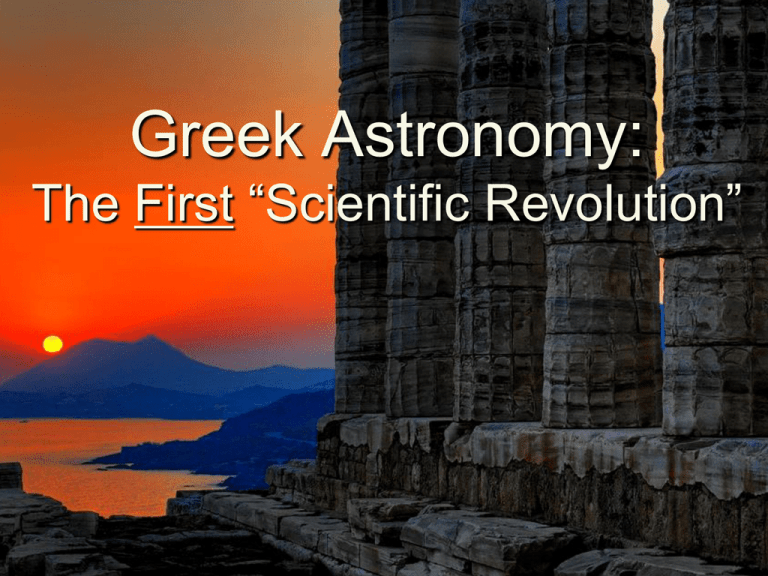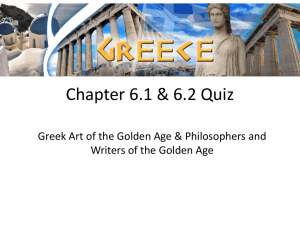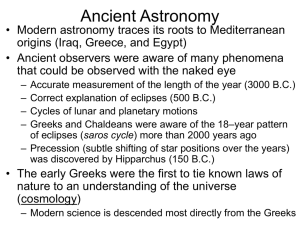Greek Astronomy
advertisement

Greek Astronomy: The First “Scientific Revolution” Athens, ca. 400 BC Puzzlah #20 Why might the Greeks have been more dependent on astronomy than a tropical culture like the Maya? (A) More extended empire to keep coordinated (B) Navigation needed for seafaring (C) Clear weather presented more astronomical phenomena that demanded explanations (D) More extremes in weather require better calendars Puzzlah #20 Why might the Greeks have been more dependent on astronomy than a tropical culture like the Maya? (A) More extended empire to keep coordinated (B) Navigation needed for seafaring (C) Clear weather presented more astronomical phenomena that demanded explanations (D) More extremes in weather require better calendars Temple of Poseidon, Sounion Gateway, Citadel of Mycenae Parthenon, Athens Dolphins & Lions of Delos The School of Athens (Raphael) Plato & Aristotle Ptolemy Pythagoras The School of Athens (Raphael) 800 Years of Greek Astronomy: 650 BC – 150 AD Greek Astronomical Timeline to 250 BC Greek Astronomical Timeline to 250 BC - Rejects mythological/supernatural explanations of nature Greek Astronomical Timeline to 250 BC Atomic theory. Plurality of worlds. Infinite universe. Greek Astronomical Timeline to 250 BC Physics, biology, astronomy. Greek Astronomical Timeline to 250 BC Physics, biology, astronomy. Mostly erroneous! Greek Astronomical Timeline to 250 BC Greek Astronomical Timeline 250 BC – 150 AD First proved for all right triangles by Pythagoras, ca. 530 BC “Irrational numbers” – a remarkable, even disturbing, discovery of the Pythagoreans E.g. Square root (2) = 1.41421356... This is not a "rational" number* It cannot be expressed as the ratio of ANY two whole numbers. There is an infinity of rational numbers, but the square root of 2 is NOT among them. * “Rational” numbers: 2, 5, 2/3, 3/2, 13/17, 129/97, 1489001/747253, ....... Impact of Mathematical Success on Greek Thinking Applied mathematical logic to thinking in other areas leading to "rational thinking" Preference for making deductions about nature from axioms or abstract principles Impact of Mathematical Success on Greek Thinking Applied mathematical logic to thinking in other areas leading to "rational thinking" x Preference for making deductions about nature from axioms or abstract principles Their science based largely on non-empirical premises Disdained making experiments Great progress in some areas, but overall success circumscribed by these biases Puzzlah # 21 You have two objects, A and B, both of which are the same shape. B weighs twice as much as A. You drop both simultaneously from a height of 3 feet. What happens? (A) A (the lighter object) hits the ground first. (B) B (the heavier object) hits the ground first. (C) They hit at the same time. Puzzlah # 21 You have two objects, A and B, both of which are the same shape. B weighs twice as much as A. You drop both simultaneously from a height of 3 feet. What happens? (A) A (the lighter object) hits the ground first. (B) B (the heavier object) hits the ground first. (C) They hit at the same time. You have just done a simple experiment that invalidates assumptions in Aristotle’s physics which were accepted for over 1300 years. (C) They hit at the same time. Greek Astronomy: Great! Rational, mathematical, logical, mostly empirical • Knew shape and size of Earth and Moon • Understood origin of lunar phases • Understood origin of eclipses • Detected (Hipparchos) polar precession • Realized (Aristarchus) that Sun is much more distant (& therefore larger) than Moon • Constructed first cosmological models that reproduced the data Greek Astronomy: Spherical Shape of Earth • Curvature of ocean horizon • • • • Different stars @ different latitudes Different length of day @ “ “ Circular Earth shadow during lunar eclipses Shadow lengths differ at different latitudes and can be used to measure the diameter of Earth (Eratosthenes) Lunar eclipse Lunar eclipse If know size of the Earth, can use shadow to estimate size of Moon. Eratosthenes and the shape and size of Earth Syene Alexandria Sun at noon, June 21: overhead at Syene, but not at Alexandria Eratosthenes Method (200 BC) Apply plane geometry: Measure d, H, S. The two (approximate) triangles are congruent . This means that S/H = d/R S H Alexandria so R = dH/S Eratosthenes answer: R = 4025 miles True value: R = 3950 miles Syene Hipparchos, ca 150 BC Star catalogs Magnitude system Precession Planetary data Aristarchus’ Heliocentric Cosmology (ca. 250 BC) Aristarchus’ Heliocentric Cosmology (ca. 250 BC) Although Aristarchus was right, the geocentric cosmology favored by Aristotle prevailed. Ultimate Greek Cosmology • Cosmic bodies are inanimate, physical objects, not supernatural beings • Model must explain their known motions • Spherical Earth at center of universe (“geocentric”) • “Superlunary” region pure, eternal, unchanging – In contrast to corrupted, changeable Earth & sublunar region • Only purely circular (“perfect”) motions allowed • Earth is stationary; universe revolves once per day around the Earth Summary of easily visible motions of celestial objects: an acceptable model must reproduce ALL Summary of easily visible motions of celestial objects: Acceptable model must reproduce ALL = 'Retrograde motion" “Retrograde Motion” of Mars Greek Universe of Nested Spheres Early Greek Model: geocentric, nested, rotating spheres Early Greek Model: geocentric, nested, rotating spheres Does this seem archaic, backward, naive, dumb? Well, try this: A Traditional “Projective” Cosmology (Indian) Ptolemy (ca. 130 AD): constructs ultimate Greek cosmological model Ptolemy’s Geocentric Universe "Epicycle" Center of Universe Epicycles are needed in a geocentric model to produce retrograde motion Ptolemy: how epicycles produce retrograde motion Puzzlah #22 Ptolemy's geocentric model for the solar system may have been wrong, but it was scientific. It made definite predictions, for example about phases shown by Venus in a telescope. In the model, when should Venus show a "gibbous" phase? A) B) C) D) Once per Earth year About half the time Once per epicyclic rotation Never n.b.: "gibbous" means more than half-full but less than full Puzzlah #22 Ptolemy's geocentric model for the solar system may have been wrong, but it was scientific. It made definite predictions, for example about phases shown by Venus in a telescope. In the model, when should Venus show a "gibbous" phase? A) B) C) D) Once per Earth year About half the time Once per epicyclic rotation Never n.b.: "gibbous" means more than half-full but less than full The Dark Ages --- END ---










